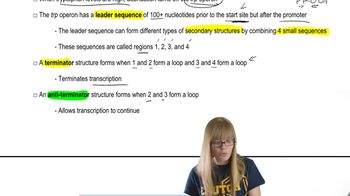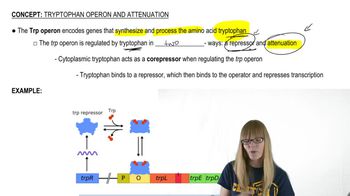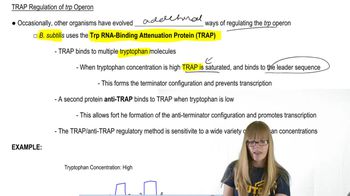Table of contents
- 1. Introduction to Genetics51m
- 2. Mendel's Laws of Inheritance3h 37m
- 3. Extensions to Mendelian Inheritance2h 41m
- 4. Genetic Mapping and Linkage2h 28m
- 5. Genetics of Bacteria and Viruses1h 21m
- 6. Chromosomal Variation1h 48m
- 7. DNA and Chromosome Structure56m
- 8. DNA Replication1h 10m
- 9. Mitosis and Meiosis1h 34m
- 10. Transcription1h 0m
- 11. Translation58m
- 12. Gene Regulation in Prokaryotes1h 19m
- 13. Gene Regulation in Eukaryotes44m
- 14. Genetic Control of Development44m
- 15. Genomes and Genomics1h 50m
- 16. Transposable Elements47m
- 17. Mutation, Repair, and Recombination1h 6m
- 18. Molecular Genetic Tools19m
- 19. Cancer Genetics29m
- 20. Quantitative Genetics1h 26m
- 21. Population Genetics50m
- 22. Evolutionary Genetics29m
12. Gene Regulation in Prokaryotes
Tryptophan Operon and Attenuation
Problem 25j
Textbook Question
What is the likely effect of each of the following mutations of the trpL region on attenuation control of trp operon gene transcription? Explain your reasoning. The start (AUG) codon of the trpL polypeptide is deleted.
 Verified step by step guidance
Verified step by step guidance1
Understand the role of the trpL region in the trp operon: The trpL region contains a leader peptide sequence that plays a crucial role in the attenuation mechanism of the trp operon, which regulates the transcription of genes involved in tryptophan synthesis.
Recognize the importance of the start codon: The start codon (AUG) is essential for the initiation of translation of the leader peptide. Without it, the ribosome cannot begin translating the trpL mRNA into the leader peptide.
Consider the impact of the mutation: If the start codon is deleted, the ribosome cannot initiate translation of the leader peptide. This means that the ribosome will not stall at the tryptophan codons in the leader sequence, regardless of tryptophan levels.
Analyze the effect on attenuation: Without translation of the leader peptide, the ribosome does not influence the formation of the attenuator structure in the mRNA. This could lead to the formation of the terminator hairpin structure, causing premature termination of transcription.
Conclude the likely outcome: The deletion of the start codon in the trpL region would likely result in constitutive attenuation, where transcription of the trp operon is prematurely terminated, regardless of tryptophan availability, potentially reducing the expression of downstream genes.
Recommended similar problem, with video answer:
 Verified Solution
Verified SolutionThis video solution was recommended by our tutors as helpful for the problem above
Video duration:
2mPlay a video:
Was this helpful?
Key Concepts
Here are the essential concepts you must grasp in order to answer the question correctly.
Attenuation in Gene Regulation
Attenuation is a regulatory mechanism in prokaryotes, particularly in the trp operon, that controls gene expression based on the availability of tryptophan. It involves the formation of specific RNA structures during transcription that can either promote or inhibit the continuation of transcription, depending on the cellular conditions.
Recommended video:
Guided course

Trp Attenuation
trp Operon Structure
The trp operon is a cluster of genes in bacteria that encode enzymes for tryptophan biosynthesis. It includes regulatory regions such as the trpL leader sequence, which plays a crucial role in attenuation by sensing tryptophan levels and influencing the formation of transcriptional terminators or antiterminators.
Recommended video:
Guided course

Trp Attenuation
Impact of Mutations on Protein Function
Mutations, such as the deletion of the start codon (AUG) in the trpL region, can significantly affect protein synthesis. In this case, the absence of the start codon would prevent the translation of the trpL peptide, disrupting the feedback mechanism that regulates the trp operon and potentially leading to unregulated transcription of tryptophan biosynthetic genes.
Recommended video:
Guided course

Proteins





